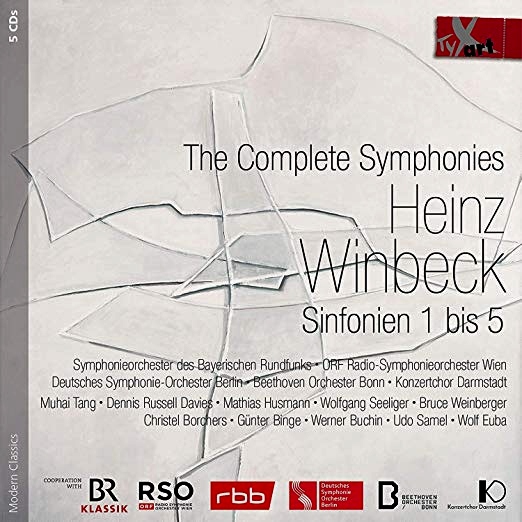
ESSENTIAL RECORDINGS

Symphony No. 1 "Tu Solus" (Live recording 1985) Symphony No. 2 (Live recording 2001) Symphony No. 3 "Grodek" (Studio recording 1991) Symphony No. 4 "De Profundis" (Live recording 1993) Symphony No. 5 "Jetzt und in der Stunde des Todes" (Live recording 2017)
I must admit that before this box-set of Symphonies by the German composer Heinz Winbeck (1946-2019) landed on my desk, I had never heard any of his music. As per my usual methodology, despite already being knee deep into the process of listening to at least a dozen or more recordings for review purposes, I always jump into a new arrival not only out of curiosity, but also to quickly segregate new recordings to a yes or no pile based on first impressions. I always do this without preliminary research, without reading the booklet notes, and without comparison to other recordings of the same music. I prefer to judge a new recording on its own merits based on three simple parameters: the integrity of the music, the tangibility of the performance, and the quality of the sound. Having said all this, I must also admit that after only a few minutes into the opening movement of the Symphony No. 1 "Tu Solus", I turned off the music, inserted the CD back in its case, and was just about to add this box-set to the no pile when a nagging little voice inside my head told me to do some research first. You see, the first movement of this symphony is loud, abrasive, and repetitive to the point of being obnoxious, with incongruous percussive blows unevenly paced throughout the whole movement. I thought to myself: "Oh no, yet another modern day composer who feels the need to shout and stomp his feet in order to be heard." Following some research on the composer and reading the booklet notes, I quickly realized that there was a method to this madness.
At the time of its composition, according to the booklet notes, Heinz Winbeck was deeply entrenched in the study of the Third and Tenth Symphonies of Gustav Mahler, as well as the history of the Third Reich. I myself personally believe that within some of Mahler's music are presentiments of horrors to come, and that by pitting some of Mahler's most beautiful and serene passages against the brutal Martellato marciale of the first movement, Winbeck was also trying to bring this revelation to the surface. Also, the inclusion of a tenor saxophone within the orchestral fabric adds a haunting touch to the orchestration. The Symphony No. 2 was written around the time of the Chernobyl fallout disaster and Winbeck readng books about the inevitable extinction of mankind. It gravitates between swift and volatile orchestral whispers and massive outbursts. The Symphony No. 4 "De Profundis", brought on by the death of his mother, deals with the extramusical concept of death. Scored for vocal soloists, choir, speaker, organ and large orchestra, it contains passages that as the booklet notes mention, are blood-curdling, as well as passages of transcendental beauty.
Last but not least, the Symphony No. 5 "Jetzt und in der Stunde des Todes" (Now and in the hour of death), abruptly takes a distant glance backwards to the end of the 19th century. At one point, Winbeck had been asked if he would be willing to take on the task of writing the final movement of Anton Bruckner's unfinished Ninth Symphony. Winbeck studied this symphony so intensely that the booklet notes state that he "almost moved and talked like Bruckner". The end result of all this was not simply a completion of Bruckner's Ninth, but a whole new Winbeck symphony inhabiting Bruckner's universe. Sure, some passages mimic Bruckner practically verbatim, but the overall effect has more to do with how Anton perceived God and the world around him. Winbeck's orchestration throughout is brilliant, and some of the more potent climaxes will leave you aghast and awestruck. The final movement alone is a slow and steady crescendo of Wagnerian proportions which, when it settles down at the end to a peaceful whisper, caps the whole symphony with a magical little twist. The Fifth Symphony alone is worth the foray into Heinz Winbeck's complex music.
The forces involved in this project include conductors Muhai Tang, Dennis Russell Davies, Mathias Husmann, singers Christel Borchers, Günter Binge, Werner Buchin, the Darmstadt Concert Choir, the Symphonieorchester des Bayerischen Rundfunks, ORF Radio-Symphonieorchester Wien, the Beethoven Orchester Bonn, and the Deutsches Symphonie-Orchester Berlin. And lets not forget the people over at the TYXart label for bringing all of this together in a nice little package.
The music of Heinz Winbeck is complex and motivated by manifold elements, and requires "serious" listening. But the rewards are worth the effort and then some. When I was just about ready to throw in the towel on this release, I'm sure glad I paid attention to that nagging little voice inside my head!
The audio clip below presents the opening pages of the final movement of the Fifth Smphony.
Jean-Yves Duperron - November 2019